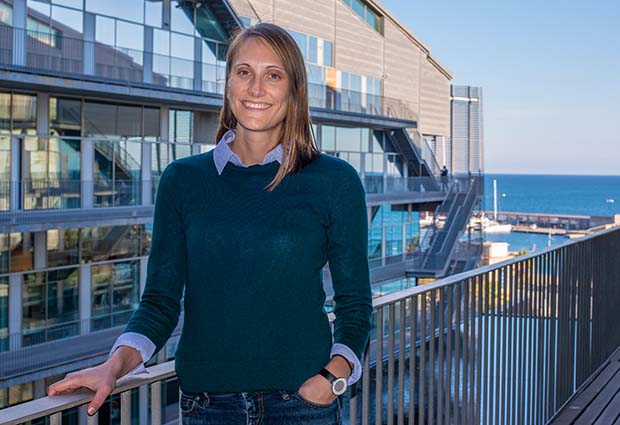
Welcome: Kristina Haase
Bringing an engineer’s perspective to vascular disease and regenerative medicine

New group leader Kristina Haase joined EMBL Barcelona in October. Her group will bring together expertise in engineering and biology to fabricate complex tissues in vitro for disease modelling and drug testing applications.
Tell me about your scientific background.
I started my academic career in mechanical engineering, as I was always fascinated by science, maths, and design processes. Although I was interested in biology, I was not keen on working with animal models. For my master’s degree, I found a project that crossed into the bio-world, and, at that time, I worked on producing a finite element analysis model for orthopaedics-related research. Afterwards, I joined an interdisciplinary biophysics group, where I started working with microscopy and experimental cell models. It was in the lab of my PhD advisor that I became captivated by the experimental design process. I was fascinated – and still am – by imaging techniques and cell culture, and by the ability to manipulate and influence how cells behave, using state-of-the-art nanotechnologies.
In my postdoc at MIT, I worked on developing different blood vessel models and tissue structures by combining human multicellular systems within engineered chips. This interdisciplinary work in vascular biology and tissue engineering has become my passion, and it’s what we aim to continue in my new group – which will focus on generating in vitro vascularised tissue-specific models. By combining human cells in millimetre-scale chips fabricated in the lab, we can effectively design vascularised tissues using their innate self-assembly process. Using different types of cells, we can engineer new tissues for regenerative medicine purposes, which will complement the use of animal models – and perhaps one day replace them altogether!
What research questions will your group be focusing on at EMBL?
Our group’s research bridges the fields of biology and engineering. We will focus on trying to answer fundamental biological questions as well as tackling real-world applications. For example, these are some of the fundamental questions we would like to answer: How do endothelial cells self-assemble and form perfusable microvascular networks? How do they do so in the presence of other tissue-specific cells? And what genes are regulating these processes? From an engineering perspective, we also want to know how the inherent mechanics of the environment can influence the self-assembly process. Looking at the bigger picture, we want to harness this capacity for self-assembly and manipulate it to develop large-scale functional human tissue patches.
What impact would you like your research to have?
Besides answering fundamental biological questions with our lab-grown tissues, there are many practical applications to our research. While one focus of the lab will be developing tissue patches – particularly for cardiac repair – another focus will be on developing drug screening tools and disease models. We’re particularly interested in modelling vascularised tumour spheroids, as well as placental tissue. We can use these tissue-specific systems to understand drug and/or immune-cell interactions, which will ultimately be important for developing patient-specific preclinical models.
What most excites you about joining EMBL?
EMBL is a well-respected institute with a strong community of researchers – a fantastic network of people to exchange and discuss ideas with. EMBL also provides access to many different kinds of established and emerging technologies. I’m excited to be working in an environment that promotes collaboration and an interdisciplinary approach to research.
What’s your philosophy for leading a team?
I hope to inspire members of my team to become curious about things we may take for granted – at least in the vascular biology community – like the collective cell behaviour process that results in formation of microvessels. This vascularisation process is fundamental for normal human development and tissue homeostasis. I think sparking interest in ambitious tissue engineering projects is exciting, but more importantly, I want our work to have a tangible and translational impact as well.
What kinds of characteristics are you looking for as you recruit your team?
I’m looking for motivated people with an underlying sense of curiosity – people who are willing to come from different academic backgrounds and try things they might not have done before. Interdisciplinary research approaches are necessary in the field of tissue engineering. I just welcomed my first PhD student to the lab, and as a biologist she’s excited to learn new techniques and skills and to tackle the engineering aspects of future projects. I’m very excited about the possibilities of who may join us next!
What’s the best advice you’ve ever received?
Interesting scientific questions do not always lead to sought-after expected results. Actually, the majority of my failed experiments have led to many more interesting findings. So, even failures can lead to promising results and they should not be discouraging. Experimental failures or mistakes are often associated with impactful scientific and technological discoveries. We’re looking forward to some unexpected discoveries in the lab!


